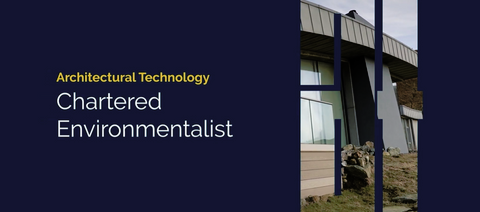Chartered Environmentalist
Chartered Architectural Technologists are at the forefront of innovations and helping develop the solutions we need to address the environmental and sustainability issues within the Built Environment sector and society as a whole.
Improving retrofit building and data-driven technologies, finding more sustainable resources, pushing for circular economy principles and policy – these are just some of the ways in which our worldwide community of Architectural Technologists are influencing change.
The Institute's Chartered Environmentalist Specialist Register will be accepting applications three times per year in April, August and December.
All future applications must be mapped against the recently revised CEnv Standards.
For further details, please contact [email protected]
About the scheme
The professional award of Chartered Environmentalist (CEnv) recognises the specialist knowledge of CIAT's members whose work contributes to mitigating and solving environmental challenges.
CIAT is licensed by The Society for the Environment (SocEnv) to award the Chartered Environmentalist (CEnv) qualification.
The CEnv qualification is granted to those who have demonstrated knowledge, proven experience, and a profound commitment to applying sustainable best practice within the area of sustainability and the environment.
Why become a CEnv?
The global built environment sector is seeing an increasing number of complex sustainability and environmental challenges, and as a result, there is growing demand for professionals who have the knowledge and experience to help solve these issues. The Chartered Environmentalist qualification, CEnv, is a demonstration of a Chartered Architectural Technologist's competence, professionalism, and dedication to providing solutions within this area.
The Chartered Environmentalist qualification gives environmental practitioners:
- a way of demonstrating their specialist competence within the sector,
- recognition of their commitment to environmental best practice within their particular field of expertise,
- professional registration with CIAT and the Society for the Environment,
- recognition beyond their specific sector.
For employers, specifying CEnv status as a recruitment requirement gives them greater confidence in the environmental competence and professionalism of potential employees.
Eligibility criteria
To become a Chartered Environmentalist, an applicant must:
- be a Chartered Architectural Technologist, MCIAT or FCIAT;
- have a relevant Masters-level degree or equivalent level of knowledge;
If you do not have a Masters-level degree, then you need to demonstrate a level of knowledge and understanding equivalent to this, and have sufficient relevant experience to be able to meet the CEnv competences. If you are not sure whether you have sufficient knowledge and/or experience, please contact [email protected].
- have sufficient, relevant and responsible practical experience to be able to demonstrate the competences;
- demonstrate underpinning knowledge related to the environment and evidence of how it is applied in practice;
- agree to comply with the Society for the Environment's Code of Professional Conduct and CPD requirements of CIAT.
As part of this, CEnv members need to submit a specific CPD Record which records their 35 hours and includes any CPD related to the CEnv competences.
For full details on the CIAT Chartered Environmentalist Register Scheme see our Candidate Guidance notes.
Application form and fees
There is a £200 joining fee which covers the cost of assessment. Applicants who are unsuccessful are advised to re-apply at a later date and will incur a re-application fee of £75.
There is also an annual subscription fee of £90 payable from 1 May each year for continued inclusion within the Register.
You can also find here the Membership and subscription fees for Chartered Environmentalist.
Watch more
The Society for the Environment has a selection of webinars that can be watched back for free if you are wondering how achieving CEnv registration can enhance your career, or what skills are required for a successful application.
How CEnv has helped me and my career #1 features three Chartered Environmentalists exploring the opportunities they have enjoyed as a result of their registration.
Achieving CEnv // The skills required for a successful application sees two experienced assessors of CEnv applications explain how to demonstrate Chartered level skills in your CEnv application.

